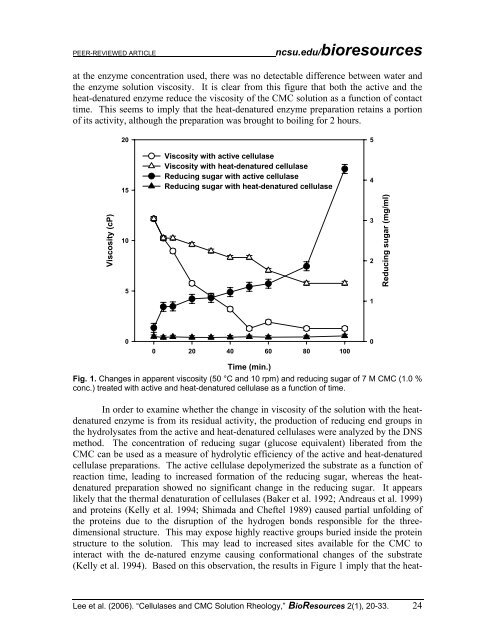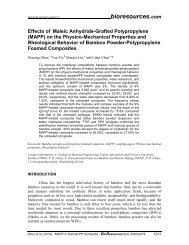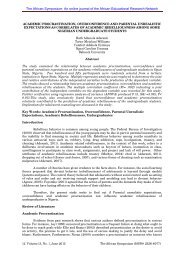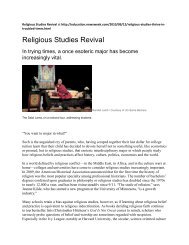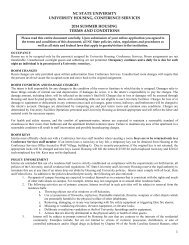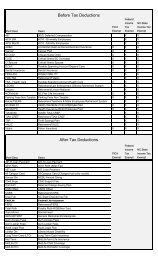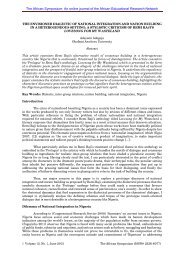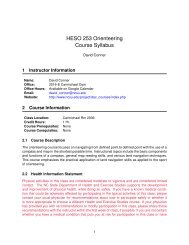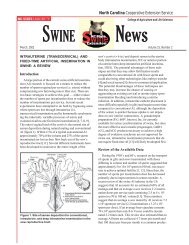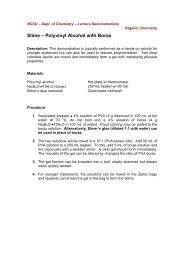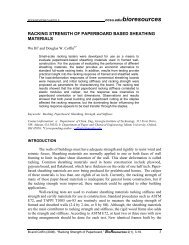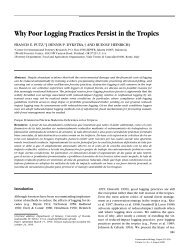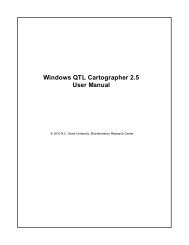Rheology of carboxymethyl cellulose solutions - North Carolina ...
Rheology of carboxymethyl cellulose solutions - North Carolina ...
Rheology of carboxymethyl cellulose solutions - North Carolina ...
You also want an ePaper? Increase the reach of your titles
YUMPU automatically turns print PDFs into web optimized ePapers that Google loves.
PEER-REVIEWED ARTICLE ncsu.edu/bioresources<br />
at the enzyme concentration used, there was no detectable difference between water and<br />
the enzyme solution viscosity. It is clear from this figure that both the active and the<br />
heat-denatured enzyme reduce the viscosity <strong>of</strong> the CMC solution as a function <strong>of</strong> contact<br />
time. This seems to imply that the heat-denatured enzyme preparation retains a portion<br />
<strong>of</strong> its activity, although the preparation was brought to boiling for 2 hours.<br />
Viscosity (cP)<br />
20<br />
15<br />
10<br />
5<br />
0<br />
Viscosity with active cellulase<br />
Viscosity with heat-denatured cellulase<br />
Reducing sugar with active cellulase<br />
Reducing sugar with heat-denatured cellulase<br />
0 20 40 60 80 100<br />
Time (min.)<br />
Fig. 1. Changes in apparent viscosity (50 °C and 10 rpm) and reducing sugar <strong>of</strong> 7 M CMC (1.0 %<br />
conc.) treated with active and heat-denatured cellulase as a function <strong>of</strong> time.<br />
In order to examine whether the change in viscosity <strong>of</strong> the solution with the heatdenatured<br />
enzyme is from its residual activity, the production <strong>of</strong> reducing end groups in<br />
the hydrolysates from the active and heat-denatured cellulases were analyzed by the DNS<br />
method. The concentration <strong>of</strong> reducing sugar (glucose equivalent) liberated from the<br />
CMC can be used as a measure <strong>of</strong> hydrolytic efficiency <strong>of</strong> the active and heat-denatured<br />
cellulase preparations. The active cellulase depolymerized the substrate as a function <strong>of</strong><br />
reaction time, leading to increased formation <strong>of</strong> the reducing sugar, whereas the heatdenatured<br />
preparation showed no significant change in the reducing sugar. It appears<br />
likely that the thermal denaturation <strong>of</strong> cellulases (Baker et al. 1992; Andreaus et al. 1999)<br />
and proteins (Kelly et al. 1994; Shimada and Cheftel 1989) caused partial unfolding <strong>of</strong><br />
the proteins due to the disruption <strong>of</strong> the hydrogen bonds responsible for the threedimensional<br />
structure. This may expose highly reactive groups buried inside the protein<br />
structure to the solution. This may lead to increased sites available for the CMC to<br />
interact with the de-natured enzyme causing conformational changes <strong>of</strong> the substrate<br />
(Kelly et al. 1994). Based on this observation, the results in Figure 1 imply that the heat-<br />
Lee et al. (2006). “Cellulases and CMC Solution <strong>Rheology</strong>,” BioResources 2(1), 20-33. 24<br />
5<br />
4<br />
3<br />
2<br />
1<br />
0<br />
Reducing sugar (mg/ml)


